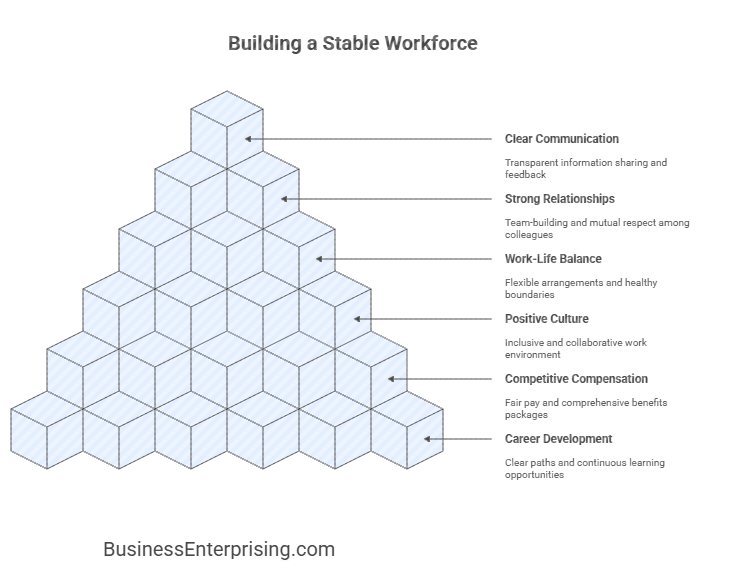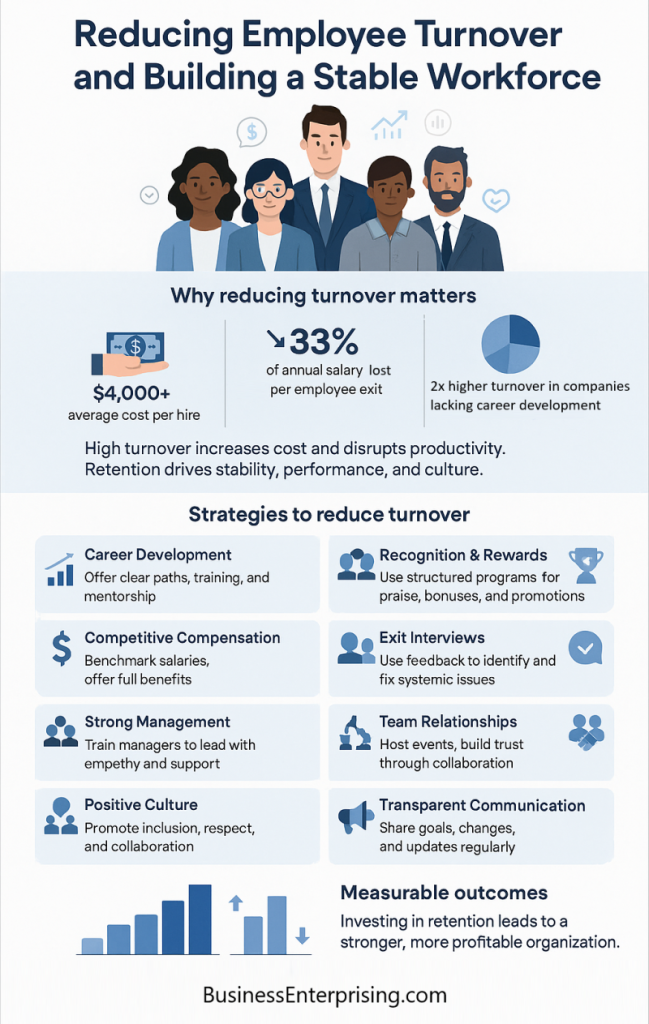
Understanding the Causes of Employee Turnover
To effectively reduce employee turnover, it is crucial to understand its root causes. Employees may leave an organization for various reasons, including lack of career development opportunities, inadequate compensation, poor management, and insufficient work-life balance. Additionally, a negative workplace culture or lack of recognition can also contribute to employees’ decisions to seek employment elsewhere. Understanding these factors allows companies to address them proactively and create a more appealing work environment.
Enhancing Career Development Opportunities
One of the primary reasons employees leave an organization is the lack of career growth and development opportunities. Providing employees with clear career paths, ongoing training, and development programs can significantly enhance their job satisfaction and commitment to the organization. Employers should invest in continuous learning initiatives, such as workshops, courses, and mentorship programs, to help employees acquire new skills and advance their careers. By fostering a culture of continuous improvement and professional growth, businesses can retain top talent and also reduce turnover.
Offering Competitive Compensation and Benefits
Competitive compensation and benefits are critical factors in employee retention. Organizations must ensure that their salary structures are competitive within their industry and region. Regularly reviewing and adjusting compensation packages to reflect market trends as well as employee performance can help retain skilled employees. Additionally, offering comprehensive benefits packages, including health insurance, retirement plans, and wellness programs, can also enhance employee satisfaction and loyalty. By demonstrating that the organization values and supports its employees, businesses can create a more committed and engaged workforce.
Improving Management Practices
Effective management plays a crucial role in reducing employee turnover. Managers should be trained to lead with empathy, provide constructive feedback, and support their team members’ professional growth. Encouraging open communication between managers and employees can help address concerns and prevent misunderstandings that may lead to dissatisfaction. Moreover, recognizing and rewarding employees’ contributions can boost morale and foster a positive work environment. By promoting strong leadership and supportive management practices, organizations can enhance employee engagement and reduce turnover.
Fostering a Positive Workplace Culture
A positive workplace culture is essential for retaining employees. Organizations should strive to create an inclusive, respectful, and collaborative work environment where employees feel valued and appreciated. Encouraging teamwork, celebrating achievements, and promoting work-life balance can contribute to a positive culture. Additionally, implementing initiatives that support diversity and inclusion can also help create a sense of belonging among employees. By fostering a supportive and inclusive workplace culture, businesses can enhance employee satisfaction and reduce the likelihood of turnover.
Enhancing Work-Life Balance
Work-life balance is a critical factor in employee retention. Employees who feel overwhelmed by their work responsibilities are more likely to seek employment elsewhere. Organizations should promote a healthy work-life balance by offering flexible work arrangements, such as remote work options and flexible scheduling. Encouraging employees to take regular breaks and also use their vacation time can also help prevent burnout. By prioritizing work-life balance, businesses can create a more sustainable and appealing work environment, reducing turnover rates.
Recognizing and Rewarding Employee Contributions
Recognition and rewards are powerful tools for reducing employee turnover and increasing employee retention. Regularly acknowledging employees’ hard work and achievements can boost morale and reinforce their commitment to the organization. Recognition can take various forms, including verbal praise, awards, bonuses, and promotions. Implementing a structured recognition program can ensure that employees feel valued and appreciated for their contributions. By consistently recognizing and rewarding employees, businesses can foster a positive work environment and reduce turnover.
Conducting Exit Interviews and Using Feedback
Exit interviews are valuable tools for understanding why employees leave as well as identifying areas for improvement. By conducting thorough exit interviews, organizations can gather insights into the factors contributing to turnover and develop strategies to address them. Additionally, seeking feedback from current employees through surveys and regular check-ins can also help identify potential issues before they lead to turnover. Implementing changes based on feedback demonstrates that the organization values its employees’ opinions and is committed to continuous improvement. By actively seeking and acting on feedback, businesses can create a more engaging and satisfying work environment.
Building Strong Employee Relationships
Strong relationships between employees and their colleagues can enhance job satisfaction and reduce turnover. Encouraging team-building activities, social events, and collaborative projects can help employees develop strong bonds and a sense of camaraderie. Additionally, promoting a culture of mutual respect and support can also create a positive work environment where employees feel connected and also engaged. By fostering strong relationships within the workplace, organizations can create a more cohesive and loyal workforce.
Providing Clear Communication and Transparency
Clear communication and transparency are essential for building trust and reducing employee turnover. Organizations should ensure that employees are well-informed about company goals, changes, and developments. Also, regularly sharing information through meetings, newsletters, and updates can help keep employees engaged and aligned with the organization’s mission. Additionally, promoting open and honest communication can also help address concerns and prevent misunderstandings. By maintaining clear communication and transparency, businesses can build a more trusting and committed workforce.
Conclusion
Reducing employee turnover requires a comprehensive approach that addresses the various factors contributing to employee dissatisfaction. By enhancing career development opportunities, offering competitive compensation and benefits, improving management practices, fostering a positive workplace culture, and promoting work-life balance, organizations can create an environment that encourages employee retention.
Recognizing and rewarding employee contributions, conducting exit interviews, building strong employee relationships, as well as providing clear communication are also critical strategies for reducing turnover. In conclusion, by implementing these strategies, businesses can build a loyal, motivated workforce that contributes to long-term success. Prioritizing employee satisfaction and engagement is essential for creating a stable and effective workforce, ultimately leading to a more prosperous and resilient organization.


